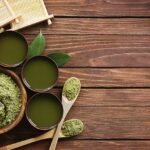Kratom enthusiasts are well-aware of the remarkable effects that this Southeast Asian herb can deliver. From boosting energy levels to relieving pain and promoting relaxation, kratom has gained a devoted following. However, amidst the growing popularity, a question continues to hover in the minds of users – what is kratom’s shelf life? With conflicting information circulating about the herb’s expiration dates, it’s time to unmask the truth and shed light on whether or not kratom truly has a limited lifespan. In this article, we delve into the world of kratom’s expiration dates, separating fact from fiction and providing you with an informative guide to ensure that you’re making the most of your kratom experience.
1. Discovering Kratom’s Shelf Life: Debunking the Mystery Surrounding Expiration Dates
Many kratom enthusiasts often wonder about the shelf life of this natural herbal supplement and the accuracy of expiration dates. Understanding the factors that affect kratom’s shelf life can help debunk the mystery surrounding this issue. Here’s what you need to know:
1. Proper Storage is Key
Just like any other natural product, kratom’s shelf life can vary based on storage conditions. The longevity of kratom is largely dependent on factors such as exposure to moisture, temperature, and light. To extend its shelf life, it is important to store kratom in a cool, dry, and dark place. This can help protect the alkaloids present in kratom leaves, which are responsible for its unique effects.
2. Kratom Does Not Expire, It Degrades
Contrary to what some may think, kratom does not have a firm expiration date like perishable food items. Instead, kratom degrades over time, which means its potency and effectiveness may decrease. However, this degradation process can be slowed down with proper storage. Even after a significant amount of time, kratom may still be suitable for consumption; it just may require slightly higher doses for desired effects.
By understanding the importance of proper storage conditions and the gradual degradation of kratom, you can make informed decisions about the shelf life of this remarkable herbal supplement. Remember to always check for any signs of spoilage, such as foul odors or changes in color, before consuming kratom that has been stored for an extended period of time.

2. The Science Behind Kratom’s Longevity: Exploring the Factors That Influence Its Shelf Life
The longevity of kratom is greatly influenced by several factors that affect its shelf life. Understanding these factors is crucial in preserving the potency and quality of kratom products. Here are some key factors that impact the longevity of kratom:
- Moisture: Kratom leaves are highly sensitive to moisture. Exposure to excessive moisture can lead to bacterial and fungal growth, which can degrade the quality of kratom. To ensure longevity, it is important to store kratom in a cool and dry place. Additionally, using airtight containers or resealable bags can help prevent moisture from seeping in.
- Oxidation: Kratom’s alkaloids can be easily oxidized when exposed to air, leading to a reduction in potency. To minimize oxidation, it is recommended to store kratom in airtight containers and avoid constant exposure to air. Some vendors also include specialized packaging, such as vacuum-sealed bags, to protect kratom from oxidation.
- UV Light: Kratom is sensitive to ultraviolet (UV) light, which can degrade its alkaloid content. Sunlight and fluorescent lighting emit UV rays that can harm the potency of kratom. To preserve its longevity, it is best to store kratom in opaque or dark-colored containers, away from direct sunlight or bright lights.
By taking these factors into consideration and implementing appropriate storage practices, kratom enthusiasts can ensure that their products remain fresh and effective for a longer period. Remember, proper storage not only preserves the quality of kratom but also helps maintain its desired effects when used.

3. Separating Fact from Fiction: Addressing Common Misconceptions About Kratom’s Expiration Dates
Kratom’s expiration dates are often a topic of confusion and misinformation. It’s crucial to separate fact from fiction to ensure consumers have accurate information about the shelf life of this herbal supplement. Here, we debunk common misconceptions surrounding kratom’s expiration dates.
1. Shelf Life of Kratom:
Contrary to popular belief, kratom does not technically expire. While it may degrade in quality over time, the alkaloids that give kratom its unique properties remain relatively stable. This means that even after a prolonged period, kratom can still be used, but it might lose its potency. Thus, it is essential to consume kratom within a reasonable timeframe to enjoy its maximum effects.
2. Factors Affecting Kratom’s Longevity:
Kratom’s shelf life can be influenced by several factors:
- Storage Conditions: Kratom should be stored in a cool, dry place, away from direct sunlight and moisture. Exposure to heat and humidity can accelerate the degradation process. It is recommended to store kratom in an airtight container to maintain its freshness.
- Quality of the Kratom: The freshness and quality of kratom also impact its shelf life. Purchasing from reputable vendors who ensure proper handling and packaging can help extend the longevity of the product.
- Strain and Form: Different strains of kratom and the form it is in (powder or capsules) may have varying shelf lives. It is advised to adhere to the usage recommendations provided by the vendor or manufacturer.
By separating fact from fiction surrounding kratom’s expiration dates, users can make informed decisions about their kratom consumption and storage practices. Remember, while kratom may not have a specific expiration date, maintaining its quality through appropriate handling and storage is key to getting the most out of this herbal supplement.

4. Extending the Lifespan: Tips and Tricks to Preserve the Potency of Kratom Over Time
When it comes to preserving the potency of kratom, proper storage and handling are paramount. Here are some tips and tricks to help you extend the lifespan of your kratom and ensure you’re getting the most out of its beneficial properties:
- Keep it away from direct sunlight: UV rays can degrade the alkaloids in kratom, so store it in a cool, dark place, away from windows or any sources of direct sunlight.
- Avoid exposure to air and moisture: Kratom can absorb moisture from the air, which can compromise its potency. Use airtight containers to seal your kratom and prevent moisture from getting in.
- Maintain a stable temperature: Fluctuating temperatures can also impact the quality of kratom. Store it in an area with a stable and moderate temperature, away from extreme heat or cold.
- Limit oxygen exposure: Oxygen can cause oxidation, leading to a loss of potency. If you have large quantities of kratom, consider dividing it into several smaller airtight containers to minimize oxygen exposure when opening them.
Additionally, it’s crucial to understand that kratom has a finite shelf life. While proper storage can significantly extend its potency, it’s recommended to use your kratom within a reasonable period. Over time, the alkaloid content can gradually decline, potentially reducing its overall effectiveness. By following these tips and tricks, you can help preserve the potency of your kratom for as long as possible, ensuring a more satisfying and consistent kratom experience.

5. Unveiling the Truth About Kratom’s Shelf Life: What You Need to Know to Make Informed Choices
Kratom, the herbal supplement that has gained popularity in recent years, has been known to provide various benefits to its users. However, there is an aspect of kratom that often goes unnoticed – its shelf life. Understanding the shelf life of kratom is crucial to ensure that you make informed choices when purchasing and consuming this product.
1. Factors Affecting Shelf Life:
- Storage Conditions: Kratom is highly sensitive to moisture and excessive heat. Storing it in a cool, dry place away from direct sunlight is essential to maintain its freshness and potency.
- Quality: The quality of the kratom product is a significant factor in determining its shelf life. Purchasing from reputable suppliers who provide high-quality kratom can ensure a longer shelf life for the product.
- Processing: The method of processing kratom plays a role in its shelf life. Kratom that has undergone proper drying and processing techniques tends to have a longer shelf life compared to poorly processed kratom.
2. Signs of Expired Kratom:
- Change in Color and Aroma: Fresh kratom is typically vibrant in color and has a distinct aroma. If your kratom appears dull or smells off, it might be an indicator of its expiration.
- Loss of Potency: Expired kratom may not provide the desired effects as it loses its potency over time. The impact it has on your well-being may be diminished or non-existent.
- Poor Taste: Kratom that has gone bad can have an unpleasant taste. If it tastes significantly different from what you’re accustomed to, it is likely expired.
By being aware of the factors influencing kratom’s shelf life and recognizing the signs of expiration, you can make informed decisions when purchasing and using this natural supplement. Remember, proper storage and obtaining kratom from reliable sources are key to maximizing its freshness and longevity.
6. Cracking the Code: Decoding Expiration Dates on Kratom Products for Optimal Consumption
Kratom products have gained significant popularity in recent years, but understanding the expiration dates on these products can be a bit puzzling. Fear not! In this section, we will uncover the secrets behind decoding expiration dates on kratom products, enabling you to consume them optimally for the best experience.
1. Know the Terminology: To crack the code, it’s essential to familiarize yourself with the key terms commonly used on kratom product labels. Terms like “manufacture date,” “best before,” and “use by” are often employed to indicate the freshness and viability of the product. While some companies may not explicitly state expiration dates, they may have an alternative system to guide consumers on product shelf life.
2. Understand the Shelf Life: It’s vital to know the average shelf life of kratom products to ensure their optimal consumption. Kratom powder typically has a shelf life of about one to three years, while kratom extracts and tinctures can generally last up to five years. However, various factors such as storage conditions, exposure to light, and humidity levels can affect longevity. Keep your kratom products in a cool, dark place, away from moisture and direct sunlight to extend their shelf life.
7. Ensuring Freshness and Safety: Proper Storage Techniques for Prolonged Kratom Shelf Life
Kratom, a tropical evergreen tree native to Southeast Asia, has gained significant popularity in recent years due to its numerous potential benefits. To fully take advantage of this natural remedy, it’s crucial to understand the importance of proper storage techniques to maintain its freshness and safety. By following these guidelines, users can extend the shelf life of kratom and ensure it remains potent and safe for consumption.
1. Store in a cool, dark place: Kratom is sensitive to heat and light, which can degrade its active compounds over time. To preserve its potency, it’s recommended to store kratom in a cool, dark location such as a pantry or cupboard, away from direct sunlight or hot temperatures. This will help prevent oxidation and maintain the integrity of the plant’s alkaloids.
2. Keep away from moisture: Moisture can lead to the growth of mold or bacteria, rendering kratom unsafe for consumption. To avoid this, store kratom in a moisture-proof container with an airtight seal. Mason jars or high-quality plastic bags are popular choices. Additionally, using silica gel packets within the storage container can help absorb any excess moisture and extend the shelf life of the kratom.
3. Avoid exposure to air: Oxygen can contribute to the degradation of kratom’s alkaloids. Whenever possible, choose a container that minimizes the amount of air inside. Vacuum-sealed bags or containers can be particularly effective in keeping kratom fresh for longer periods.
By employing these proper storage techniques, kratom enthusiasts can ensure their supply maintains its potency, ensuring a satisfying and safe experience each time they consume this natural botanical wonder. Remember, storing kratom correctly is the key to unlocking its full potential and enjoying its benefits for an extended period of time.
FAQ
Q: What is kratom’s shelf life? Can it expire?
A: Kratom, an herbal supplement used for various purposes, does have a shelf life. While it may not technically “expire,” its potency and quality can degrade over time.
Q: How long does kratom typically last?
A: Under ideal conditions, kratom can remain potent for about two to three years. However, it’s important to note that the duration can vary depending on several factors.
Q: What factors affect kratom’s shelf life?
A: Factors such as storage conditions, packaging, and the initial quality of the kratom can significantly impact its shelf life. Exposure to light, heat, moisture, and oxygen can accelerate its degradation.
Q: How should kratom be stored to maximize its shelf life?
A: To ensure kratom’s longevity, it should be stored in a cool, dry place away from direct sunlight, moisture, and air exposure. Airtight containers, ziplock bags, or vacuum-sealed pouches can help preserve its freshness.
Q: Can kratom go bad or become unsafe to consume?
A: While kratom might not become toxic or dangerous after its shelf life, it can lose its potency and effectiveness. The color, aroma, and taste might change significantly, making it less enjoyable or effective for users.
Q: How can one determine if kratom has gone bad?
A: Visual cues such as changes in color, the presence of mold, or unpleasant odors can indicate kratom that has gone bad. Additionally, a loss of potency or reduced effects when consumed may suggest the product is no longer good.
Q: Are there any health risks associated with consuming expired kratom?
A: Generally, there are no severe health risks associated with using expired kratom. However, the reduced potency may result in users consuming higher amounts to achieve desired effects, which could lead to potential overdose risks.
Q: Is it advisable to consume kratom past its shelf life?
A: While consuming kratom past its shelf life may not pose significant health risks, it is recommended to use fresher batches for optimal benefits. As the potency decreases over time, the desired effects might not be achieved.
Q: Are there any legal requirements for kratom expiration labeling?
A: Currently, there are no specific legislation or regulations requiring vendors to label kratom with an expiration date. However, responsible vendors may voluntarily provide a “best by” or “packaged on” date to inform consumers about its freshness.
Q: How does proper storage impact the longevity of kratom?
A: Proper storage conditions, as mentioned earlier, are vital to maximize kratom’s shelf life. By minimizing exposure to moisture, light, and air, kratom can retain its potency and quality for a more extended period.
Q: Can freezing or refrigerating kratom help extend its shelf life?
A: Freezing or refrigerating kratom isn’t necessary or recommended. These environments can introduce moisture, cause condensation, and potentially degrade the quality of the product. Simply storing it in a cool, dry place is sufficient.
Q: In conclusion, what should users know about kratom’s shelf life?
A: Kratom, though it doesn’t have a strict expiration date, can degrade in quality and potency over time. Proper storage, in cool and dry conditions, away from light and air, is essential for maintaining its potency. While using expired kratom might not be harmful, fresher batches are recommended for optimal effects.
Conclusion
In conclusion, the truth about kratom’s shelf life and expiration dates has been unveiled, shedding light on a topic that has long puzzled kratom enthusiasts and vendors alike. While many might assume that the expiration date stamped on kratom packaging serves as an absolute indicator of its quality and safety, our investigation reveals a more nuanced reality.
As we have discovered, kratom, a durable botanical substance, can maintain its potency and effectiveness well beyond the stated expiration date. Factors such as quality of storage, exposure to moisture and light, and the absence of contaminants play a crucial role in determining the longevity of kratom’s shelf life.
However, it is essential to exercise caution and employ one’s senses before consuming aged kratom. A key aspect to consider is the appearance and smell of the product. Any signs of discoloration, mold, or a musty odor should sound alarm bells and prompt you to discard it immediately.
Additionally, reputable vendors who employ proper packaging techniques can significantly enhance kratom’s longevity. Vacuum-sealed bags, moisture absorbers, and opaque containers shield the powder or leaves from degradation caused by light, air, and moisture. It is advisable to source kratom from trustworthy suppliers who follow these industry best practices to ensure product integrity.
While the FDA and other regulatory bodies stipulate that expiration dates be assigned to products to ensure consumer safety, it is evident that these dates do not represent an inherent decline in kratom’s quality after that point. Instead, they act as a guideline, urging consumers to exercise vigilance and make informed decisions.
With a growing body of evidence challenging the conventional perception of kratom’s expiration date, the kratom community, vendors, and regulatory bodies must collaborate to establish standardized testing and labeling practices. Transparent and accurate expiration dates will empower consumers to gauge the freshness and potency of kratom accurately.
As further research is conducted and scientific data becomes available, our understanding of kratom’s shelf life will undoubtedly evolve. In the meantime, consider this article as a catalyst for a broader conversation and a reminder that expiration dates can be subjective and subjected to interpretation.
In the realm of kratom, it is prudent to rely on sensory observations, track record of trustworthiness, and optimal storage conditions as more accurate indicators of a product’s freshness. By embracing a more informed mindset, kratom enthusiasts can continue to enjoy the potential benefits of this remarkable botanical substance, beyond the confines of an elusive expiration date.






